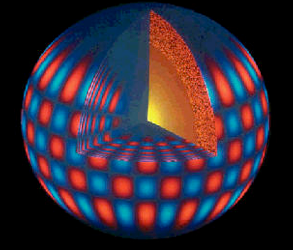astroseismology

Astroseismology is the study and measurement of acoustic vibrations in stars in order to learn more about stellar structure and evolution. Astroseismology, an outgrowth of helioseismology, had to await the development of instruments capable of detecting radial (up and down) movements in a star's surface of a few meters per second over distances measured in light-years. Such instruments are now available and are also used to search for exoplanets. The first star, other than the Sun, in which evidence of sound waves was found is the near-solar twin, Alpha Centauri A, the nearest star visible to the naked eye, which pulsates with a 7-minute cycle, similar to that observed in the Sun. Astronomers have also picked up seismological activity in more distant and non-solar-like stars, including Xi Hydrae, a giant star with a radius of about 10 solar radiiand a luminosity of about 60 times that of the Sun, lying at a distance of 130 light-years. Xi Hya, it turns out, behaves like a sub-ultra-bass instrument, oscillating with several periods of around three hours.


